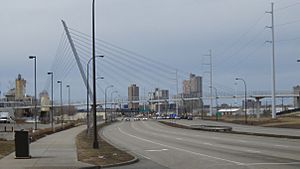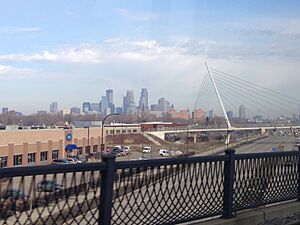Martin Olav Sabo Bridge facts for kids
Quick facts for kids Martin Olav Sabo Bridge |
|
|---|---|

The Martin Olav Sabo Bridge viewed from the south, from around 28th Street.
|
|
| Coordinates | 44°57′17″N 93°14′33″W / 44.9547°N 93.2425°W |
| Carries | Pedestrian and bicycle |
| Crosses | Minnesota State Highway 55 (Hiawatha Avenue) and METRO Blue Line |
| Locale | Minneapolis |
| Official name | Martin Olav Sabo Bridge |
| Maintained by | Minneapolis Public Works |
| Characteristics | |
| Design | cable-stayed suspension |
| Total length | 2,200 feet (671 m) |
| Height | 100 feet (30 m) |
| Longest span | 220 feet (67 m) |
| History | |
| Opened | Ribbon cutting November 8, 2007, at 4:00PM CDT |

The Martin Olav Sabo Bridge is a special bridge in Minneapolis, Minnesota. It's the first of its kind in the state, called a cable-stayed suspension bridge. This means it uses strong cables connected to tall towers to hold up the bridge deck.
The bridge is only for people walking and biking. It was named after Martin Olav Sabo, who was a very important member of the United States Congress from Minnesota for many years.
The bridge opened in November 2007. It crosses over a busy road called Hiawatha Avenue (also known as Highway 55). It connects different parts of the Minneapolis Midtown Greenway, which is a long path for biking and walking across the city. The bridge also links neighborhoods like Longfellow and Seward to the East Phillips neighborhood. It helps people get to other trails too, like the Hiawatha LRT Trail.
Hennepin County built the bridge. Now, the City of Minneapolis owns and takes care of it.
Contents
Why the Bridge Was Built
This bridge helps bikers and walkers stay safe. Before the bridge, they had to cross busy Hiawatha Avenue at street level. This meant waiting at a stoplight with cars.
Now, the bridge takes them safely over the highway. It moves the crossing point a little north. This makes it much easier and safer for everyone using the paths.
How the Bridge Is Built
The Martin Olav Sabo Bridge is very long. It stretches for about 2,200 feet (that's over 670 meters!). The main part of the bridge goes over Hiawatha Avenue. This section is 220 feet long (about 67 meters).
The tall tower that holds the cables rises 100 feet (about 30 meters) above the bridge deck. This design makes it the first true cable-stayed suspension bridge in Minnesota. A company called URS helped design this unique bridge.
History of the Bridge Name
Congressman Martin Olav Sabo played a big part in getting this bridge built. He helped get $2.9 million in money from the federal government for the project. He was known for helping Minneapolis get funding for many important city improvements.
Because of his help, city groups suggested naming the bridge after him in 2005. The City Council agreed. Hennepin County also gave money, bringing the total project cost to $5.1 million.
Bridge Repairs in 2012
In February 2012, two of the bridge's support cables broke. They fell onto the bridge deck. This caused the bridge to close right away for safety. The road and light rail tracks underneath also had to close for a short time.
Engineers found cracks where the cables connected to the bridge tower. They put in temporary supports to make the bridge safe again. The bridge reopened in June 2012 with these temporary fixes.
A report later explained why the cables broke. Strong winds made the cables vibrate a lot. This caused stress and cracks in the metal plates holding the cables. The original design didn't fully account for these wind vibrations.
To fix it permanently, the bridge closed again in September 2012. New, stronger plates were put in place. The repairs were finished, and the bridge fully reopened in November 2012.

